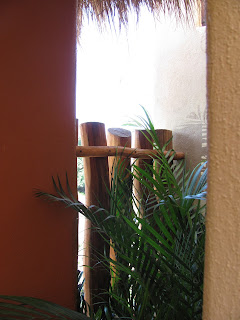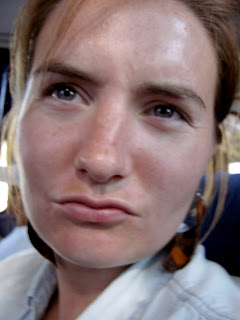The challenge: how does one design and build an off the grid, ecologically savvy, sustainable compound of bungalows on an impossibly steep jungle hillside in Mexico? When we purchased this 2 hector (5 acre) parcel of land in the jungle just north of the small town of Lo de Marcos we were simply intoxicated by the beauty of the tropical landscape. It's 270 degree backdrop of the Pacific Mexican Riviera from the inland mountain range to the rich agricultural fields to the endless expanse of the sea allowed one to view the sunrise over the mountain peaks to the sunset falling behind the curvature of the Earth as they relaxed in the dipping pool with a fresh margarita in hand. Understandably, we first and foremost thought of our dream of integrating ourselves into this jungle oasis without truly contemplating the enormous amount of work and energy it would take to create such a sanctuary. Yet with these logistical nightmares and countless limitations, such a project, especially one so personal for my family and our partners, the Perez family, manifests an unchartered blank canvass that does not hinder our ingenuity and inspiration, but promotes renewed perspectives and endless possibilities. They don't call it cutting edge design for nothing. In embarking on such a challenging project, one will find oneself coming to a point in the process where they just have to take a leap of faith and repeat the mantra: "Just do it"!
Below is a photo illustrating the difficult yet creatively inspiring terrain.
Here is another view of our property. A lagoon, beach perspective. Our tropical oasis is on the east side of the hill just under the lower ridge.
There is an endless array of elements found in the design concept to ensure that the compound will include all ecologically conscious technologies, materials and practices possible for this climate, local market and technological capacity. The goal is to create a built environment that will function as a living structure capable of processing its waste, taking in energy and water only from natural, local resources, metabolize its temperature, and erect its form and structure from the earth its founded upon.
In addressing the prerequisites stated above and in acknowledging the culture centric built environment of the Mexican coastal region, our primary concern is designing a built environment that is intrinsically weaved into the composition of the jungle ecological system. There is no need to create a division between the two environs, simply live a life rooted within the moment of place, people and culture-a life of intention.
Below you will find photos of various places I have visited since I have been in Mexico. These homes consist of exemplary integrated "indoor" and "outdoor" spaces. In essence, we are creating a built environment defined by the functional and aesthetic design template found in nature. Our home will flow from a kitchen blessed with cool breezes to sun bathed patios to vibrant, protected bedrooms and bathrooms with jungle vistas. Its form and function will constantly be evolving, just like the life of our template. Welcome to the jungle life.
An evening gathering on the large patio of the Tailwinds Ecolodge.
The rooftop deck of a Tailwinds' bungalow at dusk.
The central, covered patio at Ron and Rebecca's home (our neighbors). It serves as a open air dining room, living room and general gathering space.
The dipping pool patio amongst the jungle at Tailwinds.
An open air kitchen and dining room at a home in San Pancho. An expansive palapa roof covered the entirety of the space and provided sanctuary from the sun and rain.
Jungle integrated master suite with palapa roof.
The technicalities of building and living within an off the grid, passive house are grounded with the issues of water, energy, heating and cooling, and waste management.
WATER:
We will have the roof and platforms positioned at a slant to orchestrate a rainwater catchment system where we will store the water in large cisterns in the ground underneath the house. This stored water source will then be pumped into large containers called tonacas to be gravity fed into the showers and faucets. Below is a photo illustrating the slanted roofs of our neighbor's home in order to catch the water in a drainage system at the back of the house. The annual rainfall is around 60 inches, so with conservative water use and sufficient storage this system should suffice all of our water needs. We may also try collecting water in our two ravines located on our property. In order to do so we would need to dam the ravine and place a durable liner inside the reservoir, but that is a project farther down the trajectory.
Methods to mitigate unnecessary water use include, but are not limited to, installing composting toilets, designing a grey water system for irrigation, emphasizing a drought tolerant plant palette, utilizing low flow water heads in the showers and other traditional, alternative measures.
ENERGY:
Fortunately, our property is situated on a hillside with south orientation, so we will be collecting solar energy. We will also utilize propane gas for the stove and water heating system. Surprisingly, there are readily accessible resources for solar in Mexico and we have the expertise and experience of several local civil engineers and sustainable building consultants as well. Also, we will be able to utilize our coastal, high altitude location and compressed adobe material to create natural ventilation. This completely eliminates the issue of heating and cooling and the energy costs that accumulate rapidly. Another option is the collection of wind energy with a small turbine situated on our roof. There are endless possibilities, I will just have to examine the cost effectiveness of each item in a more intensive, practical manner.
WASTE:
With the grey water system, the accessible recycling center in the town of Lo de Marcos and the proximity of our organic farm for composting, we do not foresee waste management being a large obstacle. One of the incentives of moving to Mexico and creating a new home was to contemplate our family's footprint composed of energy, natural resource and material consumption. Our goal is to emphasize the complimentary concepts of reduce, reuse and recycle in every aspect of our life in the jungle. These concepts are the pillars to the overarching idea of RETHINKING our way of life and our presence in this multifaceted, ingenuous ecosystem.
--
Another pivotal component to ecological design is the consideration of materials: their source, their impact and projected lifeline. I am continually researching the locally sourced and ecologically sound materials that provide sufficient function and ideal aesthetic.
We have been informed that brick is one of the best locally sourced building materials. While we were never considering using concrete due to its high levels of CO2 emitted during its preparation, we have been made aware bricks superiority to concrete with its insulation qualities. On that trajectory we are now considering compressed adobe blocks that can be purchased locally from a cutting edge environmental designer. Adobe creates an ideal insulated structure that mitigates any mold or other factors induced by the humid, coastal climate.
Now, the battle between palapa (palm frond) and tile roofs. There are many different options for roofing in Mexico, but the to main methods utilized on foreign owned houses are natural palm frond palapa or tile roofs. The palapa roofs vary is size and detail, but unfortunately they must be replaced every 7-10 years. The technology surrounding this traditional method is expanding and these palm frown structures provide proficient protection from rain, sun and insects. If we utilize palapa roofs on a portion of the compound the rainfall will still runoff and be collected on the pad. The issue with palapa roofs is their timeline and if its beautiful aesthetic is cost effective. The other option, tile roofs, are also locally sourced, and create a very Mexican aesthetic. Obviously, this option is much more sustainable in terms of its longevity. One issue with the tile roofs is the aesthetic both on the house dwellers' and town's standpoint of the house being integrated into natural surroundings on this prominent landmark (a hill rising from the sea and river to the north of town). As of right now, it seems that a balance of both palapa and tile will be the best option aesthetically, ecologically and to ensure cost effectiveness. Above, you will find a photo showing a very excessive home in San Pancho that uses both materials.
Juan Ventura, a local builder in Lo de Marcos, will most likely be our contractor, builder for our project. He constructed this house as well as Ron and Rebecca's. He has built awe inspiring spaces and is proficient in ecological design and technologies.
Creative use of materials for alternative shading will definitely be considered and utilized if applicable.
This flat, smooth (flagstone) rock is some of the most durable, readily accessible material for retaining walls, which will be essential to providing support on our steep terrain.
Many opportunities to use locally sourced wood for accents and cabinetry.
There are also many varieties of wood with adaptive qualities to repel insects and the effects of the humid, coastal climate. Great ecologically conscious options.
We will begin bulldozing and leveling our pad right after the christmas holidays. Updates will be coming soon. Please comment if you have any suggestions, concerns or encouragement. Hasta pronto.









































